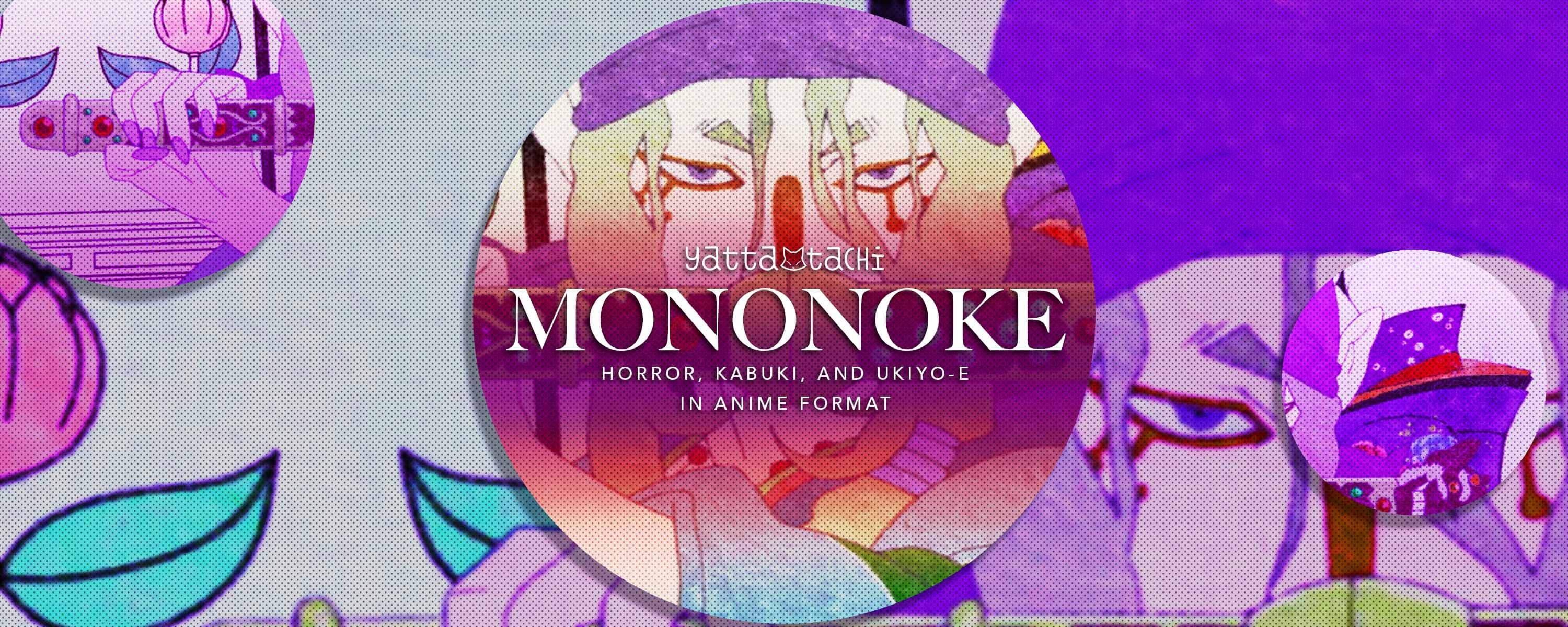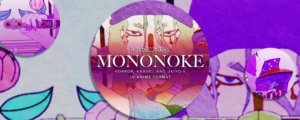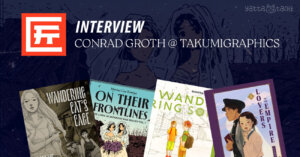Hey, it’s October! Let us talk about something spooky. I have been meaning to talk about Mononoke for a long time. No, it is not the same Mononoke as Hayao Miyazaki’s Princess Mononoke (Mononoke-hime). Mononoke is a rather undervalued show in the supernatural horror and detective genre. It takes some inspiration from ukiyo-e prints and kabuki performances mixed with the appeal of modern shounen anime. This time, instead of focusing on how good the anime is (it is great, by the way!), I’d like to look at what Mononoke has taken from kabuki performances and what makes its style of horror work.
History and brief synopsis
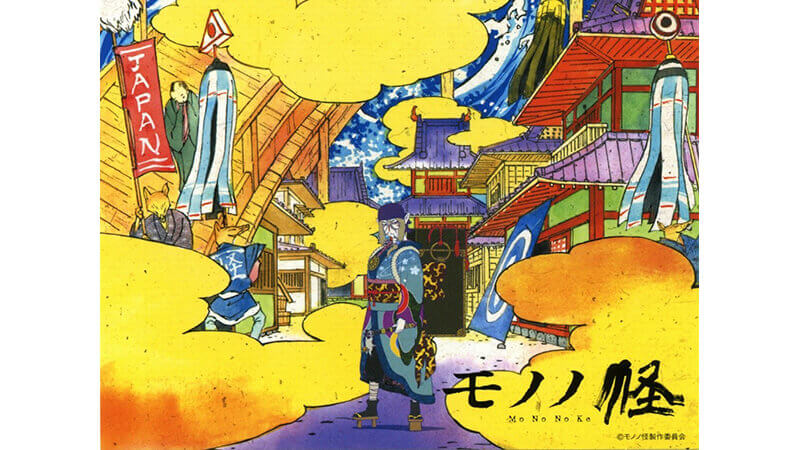
Mononoke (モノノ怪) ran in mid-2007 spanning twelve episodes. Kenji Nakamura, who is known for directing The Big O, GeGeGe no Kitarou, and the Gatchaman Crowds series, helmed the making of this anime. It is a spinoff of another anime series, Ayakashi: Samurai Horror Tales. If you look up Ayakashi: Samurai Horror Tales, you will find the art style very different from Mononoke. Nakamura directed one of the story arcs in that anime. Soon after its airtime, Mononoke was adapted into a manga based on each story of the anime.
The word mononoke, as explained in the anime, refers to malicious spirits that manifest from human’s twisted desires. The anime tells the story of a mysterious Medicine Seller. He travels and slays mononoke by using the Sacred Sword. However, the Sword can only be unsheathed after learning about the spirit’s katachi (Shape), kotowari (Reasoning), and makoto (Truth). Each story arc presents different ways of figuring those three answers out.
Mononoke’s horror style
Can horror be done in a bright and beautiful setting? Mononoke’s creators think so. While the genre normally relies on a darker atmosphere in the form of lighting, set design and such, Mononoke uses other methods. As an animation medium, it employs techniques such as weird camera angles, framing, cuts, great sound design, surreal animation, and symbolism.
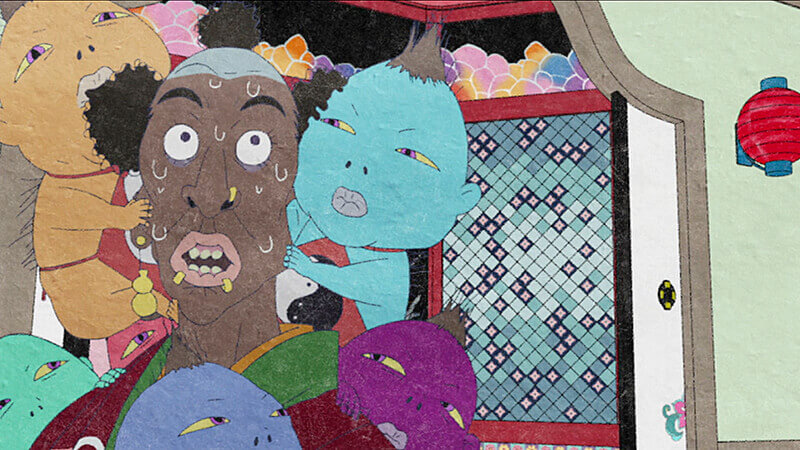
There are times when gruesome scenes happen only for us to see glimpses of what goes on. Sometimes we see flashbacks of the scenes, other times we only see the aftermath. In one instance, the director may decide to show an implication of what had happened coupled with an eerie soundtrack and haunting sound effects.
Ultimately, the anime wants to show the ugliness of human hearts. It comments that there are horrific things that we are able to commit. Those ugly deeds and dark desires eventually manifest in some mononoke. This is one theme that has haunted me the most. As much as humanity is capable of greatness, it is also capable of some truly horrible deeds.
The influences from kabuki and ukiyo-e
Japanese stage performances or theatre has a long history dating back hundreds of years. Chief among the types are Noh, Bunraku, and Kabuki. As far as the performance goes, kabuki distinguishes itself by singing, dancing, incorporating newer stories, and the elaborate make-up put on by the actors. The stage itself often has clever contraptions that allow different configurations. On certain stages, the base can rotate on an axis to allow change of scenes. Some stages have man-operated elevators to allow actors to show up dramatically from below.
The acting is very stylized, combining extravagant costumes, choreographed movements, and exaggerated postures. The performance is often memorable when the actors strike distinctive poses. Depending on the plays, there are times when the stage is filled with the characters freezing in their respective stances. Those moments often turn the lively set into a giant painting.
If you are curious about kabuki, there is a video about it below.
Sidenote about kabuki and ukiyo-e
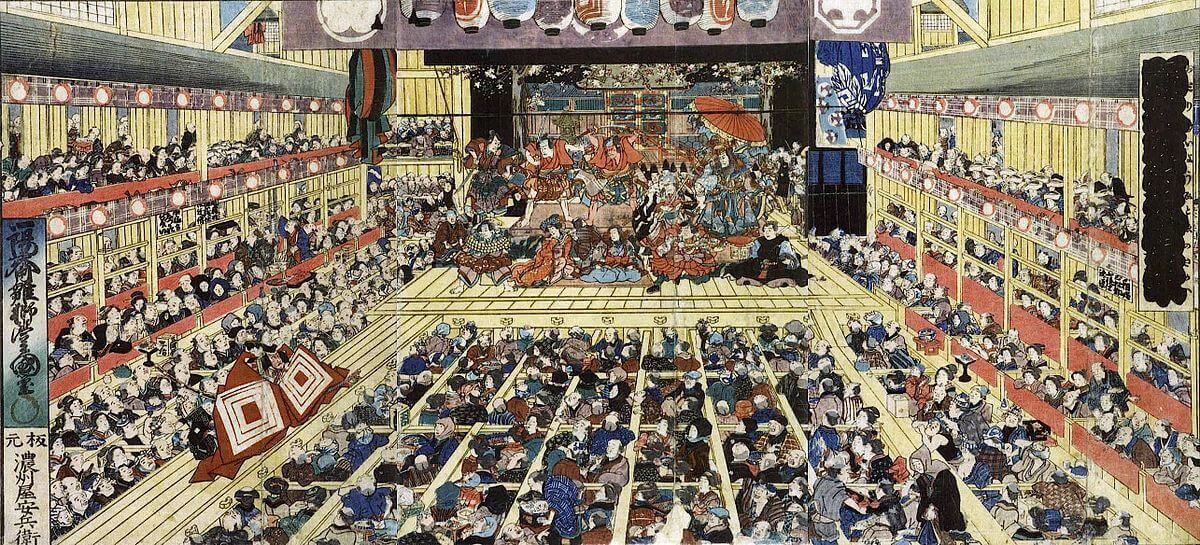
Japanese woodblock prints and paintings (ukiyo-e) have influenced kabuki in their set designs and more. Kabuki, in turn, enabled ukiyo-e to commercially thrive during its heyday. Prints of kabuki actors were very popular. There were also records of kabuki performances on prints as if they were photographs. Both media depended on each other for their popularity as well as serving as one another’s inspirations.
Combining those elements
Mononoke’s visual style mimics those beautiful ukiyo-e prints from its beautiful patterns, soft colors, paper texture, to stylized character designs and more. Its music and sound design also draw from traditional instruments used in kabuki acts. You can hear flutes, shamisen, tsuzumi drums (that often make Pon! sounds), and wood boards for effects. Bonus point unrelated to kabuki: often, certain parts of the scenes are emphasized with kagura suzu, a bell instrument used in ceremonies.
Certain scene cuts are synchronized with a particular rhythm and instruments. The early sequence of Episode 6 is a good example. One of the cuts uses a four-count rhythm of “one-one-one-one-one-hold/climax” where the one counts tell pieces of a narrative ending in a longer sixth count as the finale. Another one uses a two-one-two rhythm before following up with a one-one-one-two-two-one-one-one-half(even though there are two reactions in that half-count) before returning back to “normal”.
As I said above, the anime likes to revisit gruesome scenes that happen prior. The flashbacks are presented in two main ways: allusion and direct. Allusions to the flashbacks usually appear in the anime in the form of paintings. Those paintings are often referenced back and forth and supplemented with character voices or narration. The paintings frequently appear early in the chapters, giving you a hint of what heinous acts occurred.
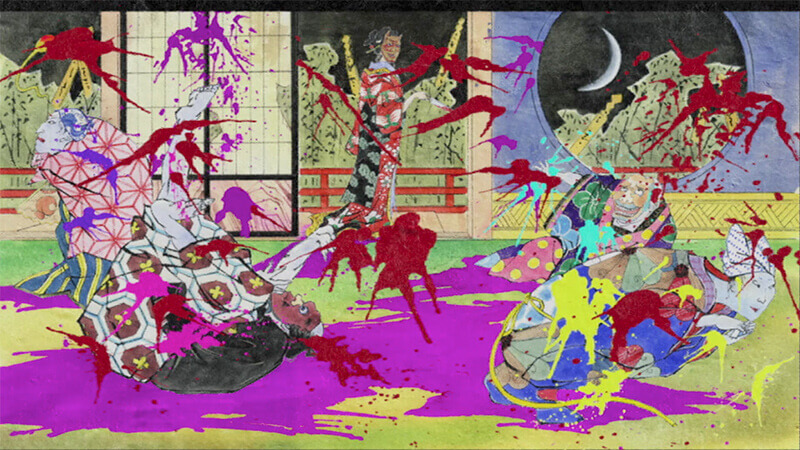
Even the blood splatters are stylized. The opening of Episode 6 is, yet again, a great example of a murder scene with splashes of different colored blood. The deliberate coloration that overlays the victims’ ukiyo-e style portraits looks like an avant-garde piece. It is an artistic choice that enhances the visual while still retaining a little visceral discomfort for the viewers. Eerie screams and demonic laughter complete the scene before abruptly cutting to another.
Whenever there are action scenes, the movements are choreographed almost resembling a kabuki dance. They have certain noticeable rhythms, just like their inspiration. Lastly, similar to the live performance, the anime often has the characters posing. In the Medicine Seller case, he is notable for his cool postures with the Sacred Sword.
Mononoke is a great example of a stylistic horror and murder mystery show. I am still surprised after re-watching the series that the show direction still holds up really well. I get chills on certain scenes and I find myself more able to empathize with the characters now. There are more things I noticed on my later viewing that I missed during my first time long ago. Though I would love for the kabuki-inspired acts to be stronger, I understand why the director chose otherwise. If you had not seen it, please have a go at it!
Mononoke is currently available on TubiTV.

Featured Sponsor - JAST
The sweetest romance and the darkest corruption, the biggest titles and the indie darlings; for visual novels and eroge, there's nowhere better.
Big thank you to our supporters
From their continous support, we are able to pay our team for their time and hard work on the site.
We have a Thank-You page dedicated to those who help us continue the work that we’ve been doing.
See our thank you page